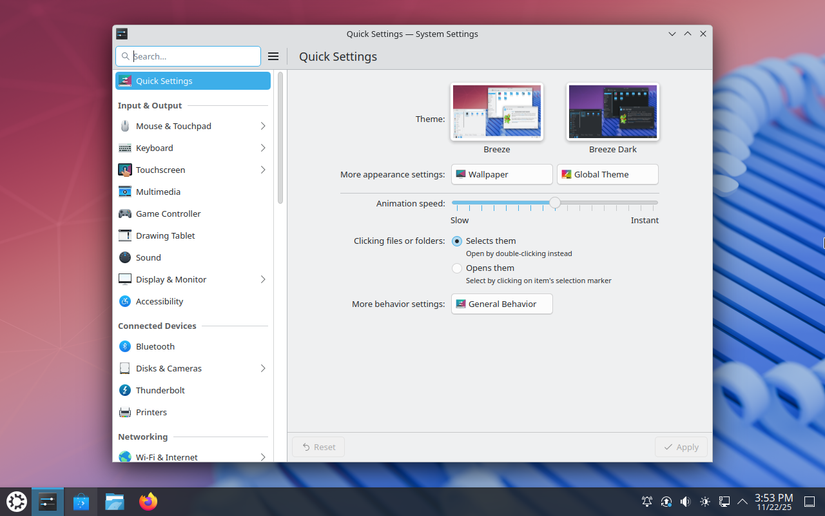With support for Windows 10 ending and some confusion still remaining in Windows 11 regarding artificial intelligence, there has never been more interest in trying out Linux than there is today. If you're looking for a Linux distribution that's easy to adapt to when moving from Windows, look no further than Kubuntu.
Submission to Windwes White
One of the biggest stumbling blocks when switching between operating systems is the user interface. How do you open and close applications? Where do you find apps? What does the settings menu navigation look like?
In this regard, Kubuntu shines.
The taskbar and Start menu are very similar to those found in Windows. I think the Start menu in Kubuntu is particularly reminiscent of the Start menu in Windows 10, with a few pinned programs on the right and a list of your apps on the left. You can pin new apps to it by right-clicking them and selecting Add to Favorites.
The Settings app is also extremely intuitive, and I would compare it favorably to the Settings menu you find in macOS. Unlike Windows, you only need to find one location. You don't have to remember which setting is hidden in Control Panel and which has been half-heartedly moved to the new Settings app.
One final bonus: Finding and installing applications on Kubuntu (like most Linux distributions) is easier than on Windows. You simply use the Discover app to add, update, and remove apps and system updates. I'd recommend starting with KDE apps if you need an app for something – they're usually excellent.
These are just a few examples, but the principle continues throughout the user interface: if you're used to Windows, you'll feel right at home with KDE Plasma on Kubuntu.
Kubuntu apps are better than Windows by default
Nobody wants to start using a new operating system only to find themselves searching for a million different applications just to use their computer as usual, and this is where Kubuntu shines again.
Kubuntu is a modified version of Ubuntu that replaces the regular Ubuntu desktop environment with KDE Plasma.
Kubuntu also comes pre-installed with several great KDE applications, such as Okular (document viewer), Dolphin (file explorer), and Konsole (terminal). Spectacle, the included screenshot program, is at least as effective as Windows Snipping Tool, and I'd say it's better in many ways.
My favorite included app is KDE Connect, which allows you to connect your phone to your computer via a local network so you can use your computer to send and receive text messages, share files between your phone and computer, and control any device. I've compared it to Microsoft Phone Link a few times and found that KDE Connect is consistently more reliable – impressive for something completely free.
In addition to what's included when you install the operating system, KDE also offers a variety of other programs that you can count on to meet your needs right away. Kdenlive, a video editing program, can compete with Adobe Premiere and DaVinci Resolve. Kate is an advanced text editor comparable to Microsoft VS Code.
I've tried a ton of KDE applications over the years, and while I don't use them all on a daily basis, they're all good. Having a one-stop solution for all your basic (and sometimes complex) applications makes switching from Windows to Linux much easier than it might otherwise be.
Debian and Kubuntu have excellent support.
Ubuntu is the most famous Linux distribution, and the base Linux distribution, Debian, supports many other popular distributions such as Linux Mint. Kubuntu on its own for the most part Ubuntu. What does this mean for the end user? Documentation for All.
Whether you're trying to troubleshoot a bug or just want to do something complex, using an Ubuntu (Debian) based system means there's a huge amount of support available online for everything. This is critical to making the transition from Windows to Linux less painful than if you had to wade through tens or hundreds of pages of technical documentation just to figure out the underlying problem.
The only area where you can't rely on Ubuntu's solutions is the desktop environment, since Kubuntu uses KDE Plasma rather than GNOME. However, KDE Plasma is very popular. on its own, and you will likely have no problem finding discussions and solutions related to any problem you may encounter.
Kubuntu runs on anything
Windows is notoriously bloated these days, and Windows 11 doesn't help solve that problem. What's more, Windows 11 also has pretty strict hardware requirements: 4GB of RAM, only supports “modern” processors, and you need TPM 2.0 – something many fully capable PCs don't have.
Again, Kubuntu, like most other Linux distributions, excels in this area. If you really wanted to, you could run it on one GB of RAM and an ancient dual-core processor. In practice, I ran Kubuntu 25.04 on systems with a 2010 quad-core processor and just 8GB of RAM and found it to be fast and responsive, while Windows 11 was horribly sluggish on the same system. When I installed Kubuntu on my 5 year old laptop, I went from worrying about how soon I'd have to buy a new laptop to having a device that feels and works like it's brand new.
If you find that Kubuntu is a little slow on an older system, you can also turn off visual effects in the settings menu to ensure faster performance.
Switching to Linux used to be a bit difficult. The user interface was not as developed as in Windows, and you often had to use the command line interface to perform basic tasks. Today this is not the case – in all my years of using Kubuntu, I have never touched the command line for “normal” tasks. And as an added bonus, you won't even have to give up gaming anymore, mainly because Proton, compatibility level included on Steam.












